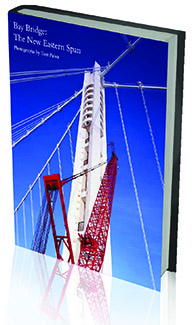Tom Paiva photographs the urban and industrial landscape, capturing the majestic, the poetic, and sometimes the achingly vulnerable artistry found in the man-made environment. His long-term passion is night photography and creating images of industrial landscapes in the shadows of twilight, or under the stars when the rest of the world is at rest.

By Paul Duclos
Published: June, 2015
In an interview with Bay Crossings, he explained that while the Metropolitan Transportation Commission (MTC)—one of the organizations in charge of the bridge project—had a handful of talented photographers shooting digital images for documentation purposes, Paiva was confident that his style and experience would offer something vastly different to what they were used to seeing.
Indeed, he eventually convinced MTC to allow him to shoot some sample images—particularly the project at night. Paiva said that what eventually won them over was his passion for the project and the formal quality of his pictures, which captured the drama and distinctiveness of the new bridge even in its earliest construction phases.
Soon after, MTC and other organizations began commissioning him to shoot regularly, including sending him to Shanghai to shoot the fabrication of the tower and other bridge sections.
Bay Crossings: Does the Bay Bridge measure up to the “iconic” standard of the Golden Gate?
Tom Paiva: The Bay Bridge, originally opened in 1936, was in operation before the Golden Gate Bridge, making it an icon in its own day. The Golden Gate, being a longer suspension bridge, became the record holder in 1937. The Bay Bridge, on the other hand, is visible from downtown San Francisco and is much longer in overall length. The new East Span is the longest self-anchored suspension span in the world and that fact, along with its sweeping beauty, will make it a Bay Area icon for years to come.
BC: How much personal risk is involved in this kind of work?
Paiva: There is always an inherent amount of risk in any industrial area, but when I was photographing this project, I was always escorted by a public information officer from MTC and an engineer from Caltrans. They kept me from doing anything that was unsafe. Safety equipment was always required—boots, vest, hard hat, safety glasses and a life preserver when over the water.
BC: How do you manage to concentrate and stay calm?
Paiva: Like everyone on this project, I was there to do a job. Typically, I’m not afraid of heights, but being on rickety scaffolding hundreds of feet above the Bay or the ground makes you become keenly aware of all your moves and actions. After a while, you become used to the monumental scale and endless walking and climbing with all my gear. I found the environment artistically stimulating and found that I had to be very selective with what I chose to shoot in the time allotted me. I was always tuned to this artistic concentration.
BC: Can you describe some of the technical challenges when documenting such an enormous project?
Paiva: The biggest technical challenge was the weather. It’s almost always cold and windy on the Bay, and working with a view camera like I did made that a challenge. The camera had to be perfectly still for sometimes a half-hour or more for the longer night exposures. Rain was an issue on occasion, as was fog. These issues were a problem, but the final images made it all worthwhile. Other challenges included coordinating the Caltrans and MTC staff to work with me well past their time to go home into the evening. The night photos I feel are the most dramatic and I thank these workers for giving me that access.
BC: What advice do you have for aspiring photographers looking for the same kind of challenges?
Paiva: A project like this is primarily about access. You can’t simply walk into the construction area and photograph. This process took months before I was able to get out and shoot. You also have to know what you’re doing, as a location like this is not a place to learn your skills. www.baybridgebook.com

